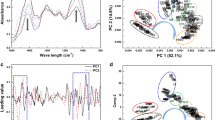Abstract
Cassava genotypes (Manihot esculenta Crantz) with high pro-vitamin A activity have been identified as a strategy to reduce the prevalence of deficiency of this vitamin. The color variability of cassava roots, which can vary from white to red, is related to the presence of several carotenoid pigments. The present study has shown how CIELAB color measurement on cassava roots tissue can be used as a non-destructive and very fast technique to quantify the levels of carotenoids in cassava root samples, avoiding the use of more expensive analytical techniques for compound quantification, such as UV-visible spectrophotometry and the HPLC. For this, we used machine learning techniques, associating the colorimetric data (CIELAB) with the data obtained by UV-vis and HPLC, to obtain models of prediction of carotenoids for this type of biomass. Best values of R2 (above 90%) were observed for the predictive variable TCC determined by UV-vis spectrophotometry. When we tested the machine learning models using the CIELAB values as inputs, for the total carotenoids contents quantified by HPLC, the Partial Least Squares (PLS), Support Vector Machines, and Elastic Net models presented the best values of R2 (above 40%) and Root-Mean-Square Error (RMSE). For the carotenoid quantification by UV-vis spectrophotometry, R2 (around 60%) and RMSE values (around 6.5) are more satisfactory. Ridge regression and Elastic Network showed the best results. It can be concluded that the use colorimetric technique (CIELAB) associated with UV-vis/HPLC and statistical techniques of prognostic analysis through machine learning can predict the content of total carotenoids in these samples, with good precision and accuracy.
Access this chapter
Tax calculation will be finalised at checkout
Purchases are for personal use only
Similar content being viewed by others
References
Rodriguez-Amaya, D.B.: A Guide to Carotenoid Analysis in Foods (2001)
Tanumihardjo, S.A., Palacios, N., Pixley, K.V.: Provitamin a carotenoid bioavailability: what really matters? Int. J. Vitam. Nutr. Res. 80, 336–350 (2010)
Stahl, W., Sies, H.: Antioxidant activity of carotenoids. Mol. Aspects Med. 24, 345–351 (2003)
La Frano, M.R., Woodhouse, L.R., Burnett, D.J., Burri, B.J.: Biofortified cassava increases β-carotene and vitamin A concentrations in the TAG-rich plasma layer of American women. Br. J. Nutr. 110, 310–320 (2013)
Sánchez, T., Ceballos, H., Dufour, D., Ortiz, D., Morante, N., Calle, F., Zum Felde, T., Domínguez, M., Davrieux, F.: Prediction of carotenoids, cyanide and dry matter contents in fresh cassava root using NIRS and Hunter color techniques. Food Chem. 151, 444–451 (2014)
CIE: The Evaluation of Whiteness. Color, 3rd edn., vol. 552, p. 24 (2004)
Rodriguez-Amaya, D., Kimura, M.: HarvestPlus handbook for carotenoid analysis. Harvest. Tech. Monogr. 59, 525–528 (2004)
R Core Team: R: A Language and Environment for Statistical Computing (2014). http://www.r-project.org/
Costa, C., Maraschin, M., Rocha, M.: An R package for the integrated analysis of metabolomics and spectral data. Comput. Methods Programs Biomed. 129, 117–124 (2015)
Max, A., Contributions, K., Weston, S., Keefer, C., Engelhardt, A., Cooper, T., Mayer, Z., Kenkel, B., Team, R.C., Benesty, M., Lescarbeau, R., Ziem, A., Scrucca, L., Tang, Y., Candan, C.: Package “caret”. Max Kuhn (2016)
Champagne, A., Bernillon, S., Moing, A., Rolin, D., Legendre, L., Lebot, V.: Carotenoid profiling of tropical root crop chemotypes from Vanuatu. South Pacific. J. Food Compos. Anal. 23, 763–771 (2010)
Chávez, A.L., Sánchez, T., Jaramillo, G., Bedoya, J.M., Echeverry, J., Bolaños, E., Ceballos, H., Iglesias, C.: Variation of quality traits in cassava roots evaluated in landraces and improved clones. Euphytica 143, 125–133 (2005)
Kljak, K., Grbeša, D., Karolyi, D.: Reflectance colorimetry as a simple method for estimating carotenoid content in maize grain. J. Cereal Sci. 59, 109–111 (2014)
Meléndez-Martínez, A.J., Britton, G., Vicario, I.M., Heredia, F.J.: Relationship between the colour and the chemical structure of carotenoid pigments. Food Chem. 101, 1145–1150 (2006)
Tibshirani, R.: Regression Selection and Shrinkage via the Lasso (1994). http://citeseer.ist.psu.edu/viewdoc/summary?doi=10.1.1.35.7574
Hoerl, A.E., Kennard, R.W.: Ridge regression: biased estimation for nonorthogonal problems. Technometrics 12, 55–67 (1970)
Zou, H.: Regularization and variable selection via the elastic net. J. Roy. Stat. Soc. Series B 67, 301–320 (2005)
Svetnik, V., Liaw, A., Tong, C., Christopher Culberson, J., Sheridan, R.P., Feuston, B.P.: Random forest: a classification and regression tool for compound classification and QSAR modeling. J. Chem. Inf. Comput. Sci. 43, 1947–1958 (2003)
Acknowledgements
To CNPq (National Counsel of Technological and Scientific Development) for financial support (Process no. 407323/2013-9), to CAPES (Coordination for the Improvement of Higher Education Personnel (CAPES), and EPAGRI (Agricultural Research and Rural Extension Company of Santa Catarina). The research fellowship from CNPq on behalf of M. Maraschin is acknowledged. The work is partially funded by Project PropMine, funded by the agreement between Portuguese FCT and Brazilian CNPq.
Author information
Authors and Affiliations
Corresponding author
Editor information
Editors and Affiliations
Rights and permissions
Copyright information
© 2017 Springer International Publishing AG
About this paper
Cite this paper
Moresco, R. et al. (2017). Classification Tools for Carotenoid Content Estimation in Manihot esculenta via Metabolomics and Machine Learning. In: Fdez-Riverola, F., Mohamad, M., Rocha, M., De Paz, J., Pinto, T. (eds) 11th International Conference on Practical Applications of Computational Biology & Bioinformatics. PACBB 2017. Advances in Intelligent Systems and Computing, vol 616. Springer, Cham. https://doi.org/10.1007/978-3-319-60816-7_34
Download citation
DOI: https://doi.org/10.1007/978-3-319-60816-7_34
Published:
Publisher Name: Springer, Cham
Print ISBN: 978-3-319-60815-0
Online ISBN: 978-3-319-60816-7
eBook Packages: EngineeringEngineering (R0)




